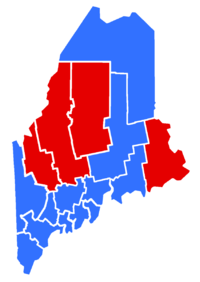Maine gubernatorial election, 2006
|
|
|||||||||||||||||||||||||||||||||||||
|---|---|---|---|---|---|---|---|---|---|---|---|---|---|---|---|---|---|---|---|---|---|---|---|---|---|---|---|---|---|---|---|---|---|---|---|---|---|
|
|||||||||||||||||||||||||||||||||||||
|
|||||||||||||||||||||||||||||||||||||

County results
Counties won by Woodcock
Counties won by Baldacci
|
|||||||||||||||||||||||||||||||||||||
|
|||||||||||||||||||||||||||||||||||||
The Maine gubernatorial election of 2006 took place on November 7, 2006. Incumbent Democrat John Baldacci was re-elected to his second term.
In the general election, Baldacci, Woodcock, Green Independent Party candidate Pat LaMarche, and independents Barbara Merrill and Phillip Morris Napier appeared on the ballot.
Woodcock never gained trust among the state's moderates and independents due to his socially conservative positions on a variety of issues. Woodcock struggled to focus on his plans for taxes and the economy such as combining the positions of registered nurse and dental hygienist, and imposing punitive "tax flourishes" upon small business owners, which Republicans believed would resonate harder with voters.
Baldacci, Merrill and LaMarche stressed economic development strategies rather than cutting taxes. Baldacci toasted the state's new and successful community college system, as well as DirigoChoice, his health care initiative. Merrill called for a rail link to Canada's Montreal which would be paid for by hosting slot machines on the trains which traveled on these rails. LaMarche boasted of universal health care as a long-term boon to the Maine economy.
...
Wikipedia

